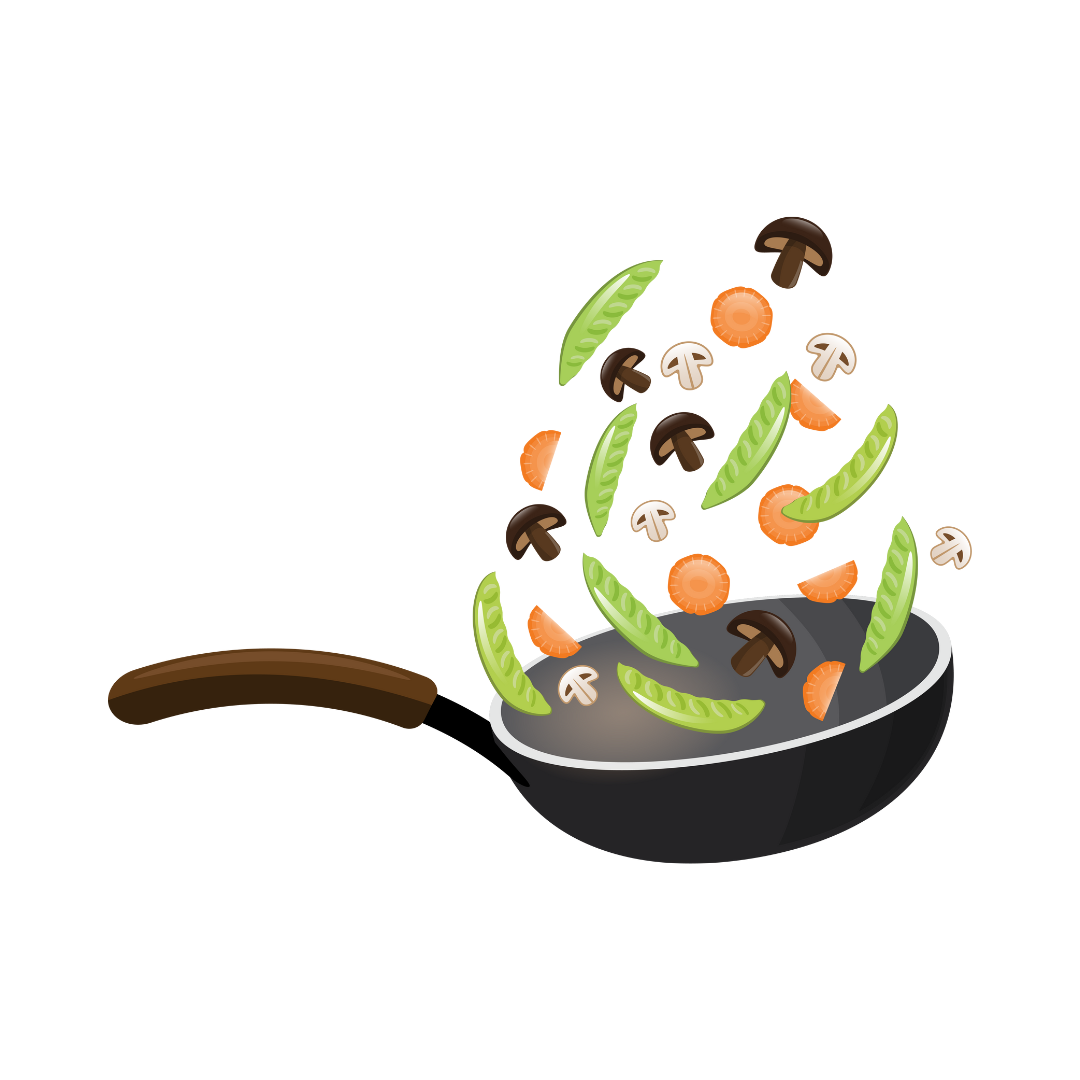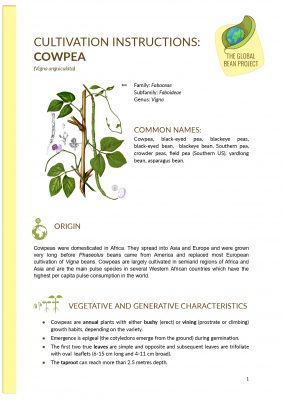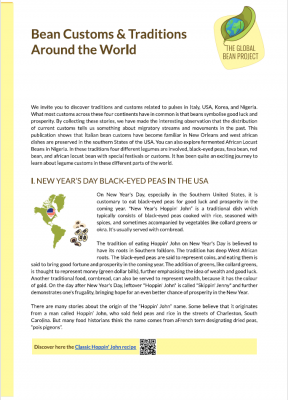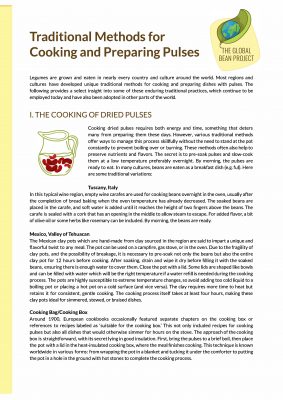Legumes are grown and eaten in nearly every country and culture around the world. Most regions and cultures have developed unique traditional methods for cooking and preparing dishes with pulses. The following provides a select insight into some of these enduring traditional practices, which continue to be employed today and have also been adopted in other parts of the world.
I. THE COOKING OF DRIED PULSES
Cooking dried pulses requires both energy and time, something that deters many from preparing them these days. However, various traditional methods offer ways to manage this process skillfully without the need to stand at the pot constantly to prevent boiling over or burning. These methods often also help to preserve nutrients and flavors. The secret is to pre-soak pulses and slow-cook them at a low temperature preferably overnight. By morning, the pulses are ready to eat. In many cultures, beans are eaten as a breakfast dish (e.g. ful). Here are some traditional variations:
Tuscany, Italy
In this typical wine region, empty wine carafes are used for cooking beans overnight in the oven, usually after the completion of bread baking when the oven temperature has already decreased. The soaked beans are placed in the carafe, and soft water is added until it reaches the height of two fingers above the beans. The carafe is sealed with a cork that has an opening in the middle to allow steam to escape. For added flavor, a bit of olive oil or some herbs like rosemary can be included. By morning, the beans are ready.
Mexico, Valley of Tehuacan
The Mexican clay pots which are hand-made from clay sourced in the region are said to impart a unique and flavorful twist to any meal. The pot can be used on a campfire, gas stove, or in the oven. Due to the fragility of clay pots, and the possibility of breakage, it is necessary to pre-soak not only the beans but also the entire clay pot for 12 hours before cooking. After soaking, drain and wipe it dry before filling it with the soaked beans, ensuring there is enough water to cover them. Close the pot with a lid. Some lids are shaped like bowls and can be filled with water which will be the right temperature if a water refill is needed during the cooking process. The pots are highly susceptible to extreme temperature changes, so avoid adding too cold liquid to a boiling pot or placing a hot pot on a cold surface (and vice versa). The clay requires more time to heat but retains it for consistent, gentle cooking. The cooking process itself takes at least four hours, making these clay pots ideal for simmered, stewed, or braised dishes.
Cooking Bag/Cooking Box
Around 1900, European cookbooks occasionally featured separate chapters on the cooking box or references to recipes labeled as ‘suitable for the cooking box.’ This not only included recipes for cooking pulses but also all dishes that would otherwise simmer for hours on the stove. The approach of the cooking box is straightforward, with its secret lying in good insulation. First, bring the pulses to a brief boil, then place the pot with a lid in the heat-insulated cooking box, where the meal finishes cooking. This technique is known worldwide in various forms: from wrapping the pot in a blanket and tucking it under the comforter to putting the pot in a hole in the ground with hot stones to complete the cooking process.
II. TRADITIONS WITH PRE-SOAKED, NOT COOKED PULSES
Thanks to modern kitchen gadgets like blenders and mixers, preparing traditional dishes with pulses that are pre-soaked and not cooked can be quite quick and easy nowadays. In former times, pounding with pestles was required which was physically demanding and time-consuming.
Please be aware that only certain varieties can be used for this preparation method, such as fava beans, chickpeas, black-eyed peas, and mung beans. These varieties contain less phasine and are therefore suitable for shorter cooking times by frying or steaming. This method is not suitable for other types of pulses.
Falafel – Fava Beans/Chickpeas Fritter
Most likely originating in Egypt and speculated to have a history dating back to Pharaonic times, falafel is typically made with fava beans (in Egypt) or chickpeas (Palestinian Cuisine), or a combination of both (Jordan, Lebanon, Syria, and the wider Middle East). The fava beans/chickpeas are soaked overnight and then ground together with various ingredients such as parsley, scallions, and garlic. Spices like cumin and coriander are often also added. The mixture is shaped into balls or patties, a process that can be done by hand or with a tool called an aleb falafel (falafel mould). The mixture is usually deep-fried but can also be oven-baked.
Akara/Acaraje/Kosse – Black Eyed Beans Fritter
Said to have originated with the Yoruba tribe of Nigeria, Akara has found its way to most West African countries and even Brazil. These black-eyed fritters were traditionally eaten for breakfast with a bowl of pap (akamu – fermented corn pudding) or stuffed in a freshly baked bread loaf. They are also suitable for evening snacks or appetizers. After soaking the beans, peel the skin with your hands (or the easy way nowadays: use a blender and pulse to split the beans). Blend the peeled beans with ingredients like onions, peppers, salt, and spices, and whisk the batter until it becomes airy and fluffy. Fry the batter by spoonfuls in hot oil in a pan until golden brown. Similarly, Bara is a black mung bean donut-shaped fritter (originated from India), and Newari woh is a black mung bean pancake (originated from the Newars in the Kathmandu valley in Nepal).
Abará – Black Eyed Beans Puree steamed in banana leaves
Abará is a popular Brazilian snack originally from Nigeria and is similar to Acarajé. However, the uncooked and peeled black-eyed beans are mashed into a puree and beaten with a wooden spoon to make it light and voluminous. The puree is then wrapped in banana leaves and put in a steamer or a bain-marie for about 40 minutes. The dish is typically served at room temperature and is best accompanied by a freshly-made hot pepper sauce. Abará is closely associated with Candomblé, an Afro-Brazilian religion, where it is one of the ritual foods offered to the gods and goddesses during ceremonial festivities.
III. TRADITIONS WITH FERMENTATION
Spontaneous Fermentation 
Farinata
Farinata is a popular street food in Genoa, Italy, made with just chickpea flour, water, olive oil, and salt. It’s fairly easy to make, but the key to making good farinata is to let the batter rest ideally for four hours or more. This allows the chickpea flour to absorb the liquid, resulting in farinata that is custardy and not dry. The batter for farinata is traditionally poured into a wide, shallow cast iron or copper pan and baked in a very hot oven. It is ready when soft and creamy in the center, with a delicate lacy crust.
Shan Tofu/Burmese Tofu
This specialty from Shan State in eastern Myanmar is made of chickpea flour, cooked into a paste similar to Italian polenta. The cooled mass is cut into pieces. In the traditional way, the chickpea flour hydrates in water two times: first for 12 hours, then again for 3 hours before cooking. The soaked chickpea flour is cooked with boiling water and stirred constantly until the mass has thickened. Transfer to an oiled pan for cooling before you cut it into pieces. Shan tofu can be eaten in salads, soups, or deep-fried.
Similar: Panisse from France.
Dosa/Dosai/Enduri/Idli
These crispy or soft crepes are made with ground and fermented black gram (urad dal/black mung beans) and rice batter and are a popular breakfast or snack in India. To make the batter, the lentils and rice are soaked separately in water for 4 to 5 hours, then ground separately to a fine consistency. The black gram batter and the rice batter are mixed with salt in a wide bowl or pan. This batter ferments overnight or for at least 8 hours. During fermentation, the batter increases in volume, develops a pleasant fermented aroma, and acquires a slightly sour taste.
For dosa (crepes): the fermented batter is poured onto a seasoned cast-iron pan or skillet (tawa), spread like a pancake, and cooked until crispy and golden, with a drizzle of oil or ghee.
For enduri (cakes): place scoops of the batter on turmeric or banana leaves, fold them and place them in a basket over a water bath. Covered with a lid, the cakes are steamed for 30-40 minutes. When the cake doesn’t stick to the leaf anymore, it is ready. Serve semi-hot.
Doenjang – Korean Soybean Paste
The Korean soybean paste is made by fermenting cooked soybeans with salt for 6 months or more. It seems similar to Japanese Miso, but Doejang is made just from soybeans and salt only. It tastes stronger, deeper and more complex than Miso, which is milder, smoother, and sweeter.
The traditional slow method: These soybean pastes are made by first allowing meju blocks to ferment in brine for a couple of months to produce a black liquid which is Korean Gukganjang soy sauce. The soy sauce liquid is then drained away and the remaining dark brown meju solids are mixed with salt and chili powder. This mixture is left to ferment for another 2 – 3 months (minimum). This is the classic/traditional kind that every year and every household had this as the most basic Korean soybean paste.
Fermentation with Starters
Tempeh – Rhizopus Oligosporus
This traditional Indonesian staple product is used extensively and in many different ways in Indonesian cuisine. It consists exclusively of cooked soybeans that are inoculated with a special mold of the Rhizopus species. The fermentation process produces a firm loaf that is high in protein and fiber, and much more digestible than just cooked legumes.
Miso – Aspergillus Oryzae/Koji
Miso is a traditional and essential condiment in Japanese cuisine. Making miso with soybeans takes two days, with maturing taking about 6 months.
Day 1: Wash the soybeans and soak for 18 hours. Day 2: Cook the soybeans until tender. Combine the cooked beans with salt and koji (steamed rice – or another grain – that has been treated with the fermentation culture Aspergillus oryzae). Put the mixture into a jar, store it, and wait for 6 months.
Similar: soy sauce.
Natto – Bacillus Subtilis
Made of cooked soybeans that have been fermented with Bacillus subtilis bacteria (usually for between 24 to 36 hours) at a steady temperature of 100 degrees F, natto is often served as a breakfast food in Japan. It has a very distinctive flavor and texture – stinky and slimy.
Stinky Tofu – Fermented Bean Curd
Fermented tofu is popular at night markets across southern China and Taiwan. It gets its name from the preparation process, which involves fermenting fresh tofu for more than 24 hours in fermented bean curd and water. The longer the tofu ferments, the stinkier and tastier it becomes. It is then fried and usually coated in oyster sauce.
IV. ROASTING

Kinako – Soybean Powder
Kinako is roasted soybean powder and a classic condiment in traditional Japanese cuisine for sweets. As the dried soybeans slowly roast, their natural sugars caramelize, unlocking a delicate, nutty flavor. It’s then ground into a powder and is a versatile addition as an ingredient or topping.
Roasted pulses – snack/topping
A traditional, healthy snack in many countries. Preparation methods vary depending on the legume type. Soybeans are roasted when dried, whereas chickpeas are soaked or cooked before roasting. Usually roasted in the oven, sometimes deep-fried.
Besan Ladoo – Sweet Chickpea Balls
Traditional Indian sweet balls are made with chickpea flour, ghee, powdered sugar, and cardamom. The chickpea flour is slowly roasted in ghee until it becomes aromatic and golden in color. Once they have cooled down and are warm, powdered sugar and cardamom are added. Small portions are rolled into balls and ready to eat. They should be stored in an airtight container and used within three weeks.
V. TOFU
Tofu making was first recorded during China’s Han dynasty about 2000 years ago and later spread, mostly in conjunction with Buddhism, to Japan, Vietnam, and other parts of Southeast Asia, where regional variations in production methods, texture, flavor, and usage can be seen. Tofu is composed of three ingredients: soybeans, water, and a coagulant—usually nigari (magnesium chloride) or gypsum (calcium sulfate). Typical tofu-making procedures involve cleaning, soaking, grinding beans in water, filtering, boiling, coagulating, and pressing (resulting in varying degrees of softness: silken, soft, firm, extra firm). Tofu is a traditional component of East Asian and Southeast Asian cuisines with many variations in savory and sweet dishes.




